Stable Reusability of Nanocellulose Aerogels with Amino Group Modification in Adsorption/Desorption Cycles for CO2 Capture
Abstract
:1. Introduction
2. Materials and Methods
2.1. Synthesis of Nanocellulose Aerogels
2.2. Nanocellulose Aerogel Silylation with N-[3-(Trimethoxysilyl) Propyl] Ethylenediamine (DAMO)
2.3. Characterization
2.4. CO2 Adsorption Measurements
2.5. Nanocellulose Aerogel Adsorption/Desorption Cycle Study (TGA)
3. Results
3.1. Infrared Spectroscopy Analysis (FTIR)
3.2. Elemental Analysis (C, H, and N)
3.3. Nanocellulose Aerogel Thermo-Gravimetric Analysis (TGA)
3.4. Scanning Electron Microscopy (VP-SEM)
3.5. X-Ray Photoelectron Spectroscopy (XPS)
3.6. CO2 Absorption Isotherms at 273 K
3.7. CO2 Absorption Capacity Through Pressure Decay Technique at 298 K and 4 Bar
3.8. Nanocellulose Aerogel Lifespan
4. Conclusions
Supplementary Materials
Author Contributions
Funding
Institutional Review Board Statement
Informed Consent Statement
Data Availability Statement
Acknowledgments
Conflicts of Interest
References
- Climate Change. Synthesis Report, IPCC. 2023. Available online: https://www.ipcc.ch/report/ar6/syr/ (accessed on 26 October 2024).
- IEA. IEA Energy Technology Perspectives 2020. Available online: https://www.iea.org/reports/energy-technology-perspectives-2020 (accessed on 26 October 2024).
- Jiang, Y.; Xu, S.; Kothandaraman, J.; Snowden-Swan, L.; Hefty, M.; Whitfield, M. Emerging Technologies Review: Carbon Capture and Conversion to Methane and Methanol; Pacific Northwest National Laboratory: Richland, WA, USA, 2024. [Google Scholar] [CrossRef]
- Patel, H.A.; Byun, J.; Yavuz, C.T. Carbon Dioxide Capture Adsorbents: Chemistry and Methods. Chem. Sus. Chem. 2017, 10, 1303–1317. [Google Scholar] [CrossRef]
- Pardakhti, M.; Jafari, T.; Tobin, Z.; Dutta, B.; Moharreri, E.; Shemshaki, N.S.; Suib, S.; Srivastava, R. Trends in Solid Adsorbent Materials Development for CO2 Capture. ACS Appl. Mater. Interfaces 2019, 11, 34533–34559. [Google Scholar] [CrossRef]
- Ho, N.A.; Leo, C.P. A review on the emerging applications of cellulose, cellulose derivatives, and nanocellulose in carbon capture. Environ. Res. 2021, 197, 111100. [Google Scholar] [CrossRef]
- Zhu, W.; Chen, M.; Jang, J.; Han, M.; Moon, Y.; Kim, J.; You, J.; Li, S.; Park, T.; Kim, J. Amino-functionalized nanocellulose aerogels for the superior adsorption of CO2 and separation of CO2/CH4 mixture gas. Carbohydr. Polym. 2024, 323, 121393. [Google Scholar] [CrossRef] [PubMed]
- Valdebenito, F.; García, R.; Cruces, K.; Ciudad, G.; Chinga-Carrasco, G.; Habibi, Y. CO2 adsorption of surface-modified cellulose nanofibril films derived from agricultural wastes. ACS Sustain. Chem. Eng. 2018, 6, 12603–12612. [Google Scholar] [CrossRef]
- Wu, Y.; Zhang, Y.; Chen, N.; Dai, S.; Jiang, H.; Wang, S. Effects of amine loading on the properties of cellulose nanofibrils aerogel and its CO2 capturing performance. Carbohydr. Polym. 2018, 194, 252–259. [Google Scholar] [CrossRef] [PubMed]
- Li, Y.; Jia, P.; Xu, J.; Wu, Y.; Jiang, H.; Li, Z. The aminosilane functionalization of cellulose nanofibrils and the mechanical and CO2 adsorption characteristics of their aerogel. Ind. Eng. Chem. Res. 2020, 59, 2874–2882. [Google Scholar] [CrossRef]
- Zhang, T.; Zhang, Y.; Jiang, H.; Wang, X. Aminosilane-grafted spherical cellulose nanocrystal aerogel with high CO2 adsorption capacity. Environ. Sci. Pollut. Res. 2019, 26, 16716–16726. [Google Scholar] [CrossRef]
- Zhang, T.; Zhang, W.; Zhang, Y.; Shen, M.; Zhang, J. Gas phase synthesis of aminated nanocellulose aerogel for carbon dioxide adsorption. Cellulose 2020, 27, 2953–2958. [Google Scholar] [CrossRef]
- Sepahvand, S.; Jonoobi, M.; Ashori, A.; Gauvin, F.; Brouwers, H.J.; Oksman, K.; Yu, Q. A promising process to modify cellulose nanofibers for carbon dioxide (CO2) adsorption. Carbohydr. Polym. 2020, 230, 115571. [Google Scholar] [CrossRef]
- Gebald, C.; Wurzbacher, J.A.; Tingaut, P.; Zimmermann, T.; Steinfeld, A. Amine-Based Nanofibrillated Cellulose as Adsorbent for CO2 Capture from Air. Environ. Sci. Technol. 2011, 45, 9101–9108. [Google Scholar] [CrossRef] [PubMed]
- Saito, T.; Isogai, A. Ion-exchange behavior of carboxylate groups in fibrous cellulose oxidized by the TEMPO-mediated system. Carbohydr. Polym. 2005, 61, 183–190. [Google Scholar] [CrossRef]
- Koros, W.J.; Paul, D.R. Design considerations for measurement of gas sorption in polymers by pressure decay. J. Polym. Sci. Part B Polym. Phys. Ed. 1976, 14, 1903–1907. [Google Scholar] [CrossRef]
- Hannon, M.J. Fast and accurate core analysis by the full-immersion pressure-pulse decay: Part 1—Theory. SPE Res. Eval. Eng. 2020, 23, 1190–1202. [Google Scholar] [CrossRef]
- Liu, S.; Wang, H.; Sang, S.; Liu, T.; Zheng, S. Effects of pore structure changes on the CH4 adsorption capacity of coal during CO2-ECBM. Fuel 2022, 330, 125529. [Google Scholar] [CrossRef]
- Chang, Y.; Yao, Y.; Wang, L.; Zhang, K. High-Pressure adsorption of supercritical methane and carbon dioxide on Coal: Analysis of adsorbed phase density. Chem. Eng. J. 2024, 487, 150483. [Google Scholar] [CrossRef]
- Baraka, F.; Labidi, J. The emergence of nanocellulose aerogels in CO2 adsorption. Sci. Total Environ. 2024, 912, 169093. [Google Scholar] [CrossRef] [PubMed]
- Aquino, G.D.; Moreno, M.S.; Piqueras, C.M.; Benedictto, G.P.; Pereyra, A.M. Alternative Synthesis of MCM-41 Using Inexpensive Precursors for CO2 Capture. Inorganics 2023, 11, 480. [Google Scholar] [CrossRef]
- Wilcox, J. Carbon Capture; Springer: New York, NY, USA, 2012; Available online: https://link.springer.com/book/10.1007/978-1-4614-2215-0 (accessed on 26 October 2024).
- Jia, P.; Xu, J.; Wang, X.; Chen, Z.; Xie, Z.; Jiang, H. Comparison of characteristics of the cellulose nanocrystal aerogels aminosilane-functionalized through gas-phase reaction. J. Porous Mater. 2022, 29, 745–758. [Google Scholar] [CrossRef]
- Titinchi, S.J.; Piet, M.; Abbo, H.S.; Bolland, O.; Schwieger, W. Chemically Modified Solid Adsorbents for CO2 Capture. Energy Procedia 2014, 63, 8153–8160. [Google Scholar] [CrossRef]
- Anas, M.; Gönel, A.G.; Bozbag, S.E.; Erkey, C. Thermodynamics of Adsorption of Carbon Dioxide on Various Aerogels. J. CO2 Util. 2017, 21, 82–88. [Google Scholar] [CrossRef]
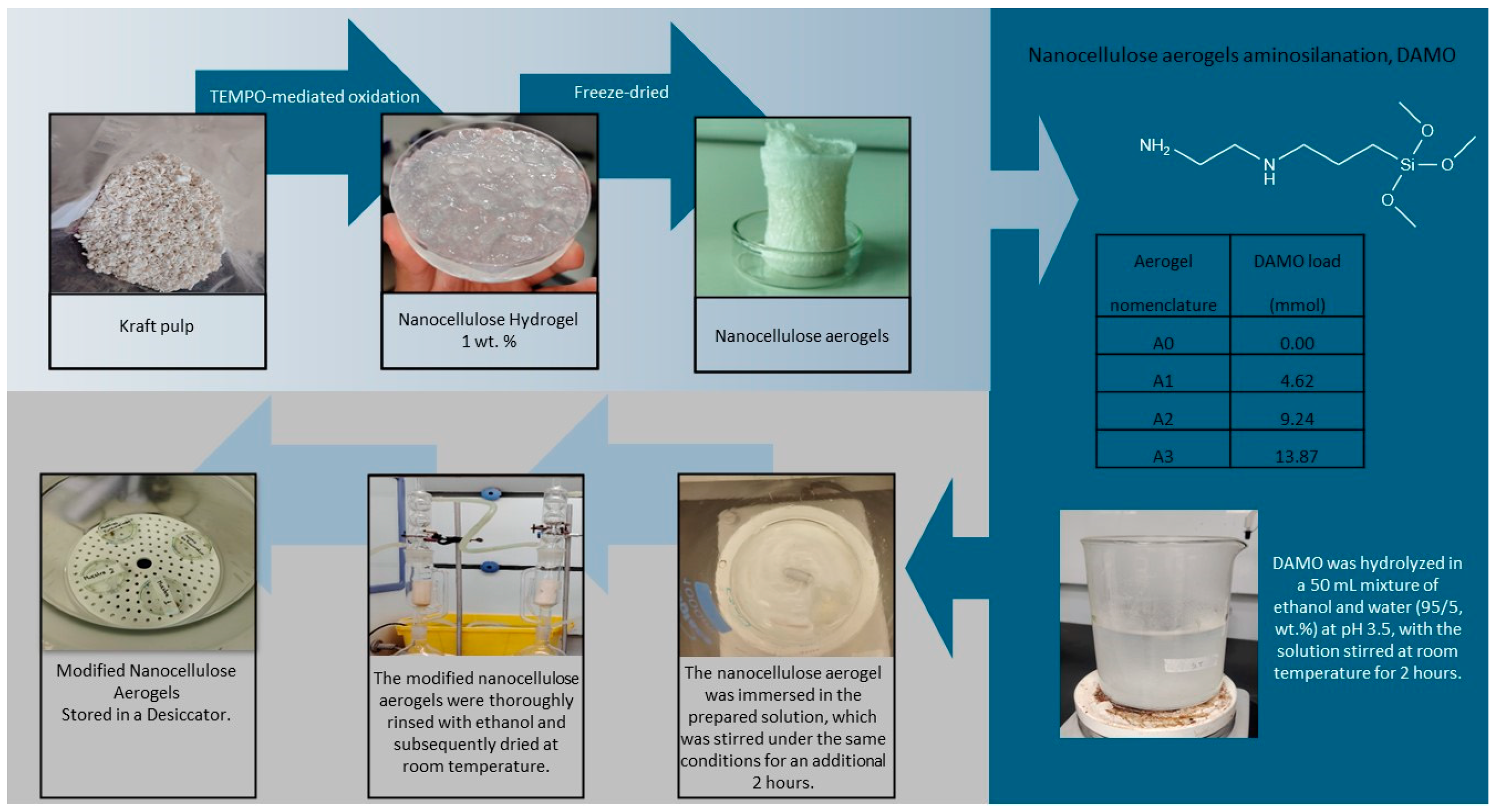
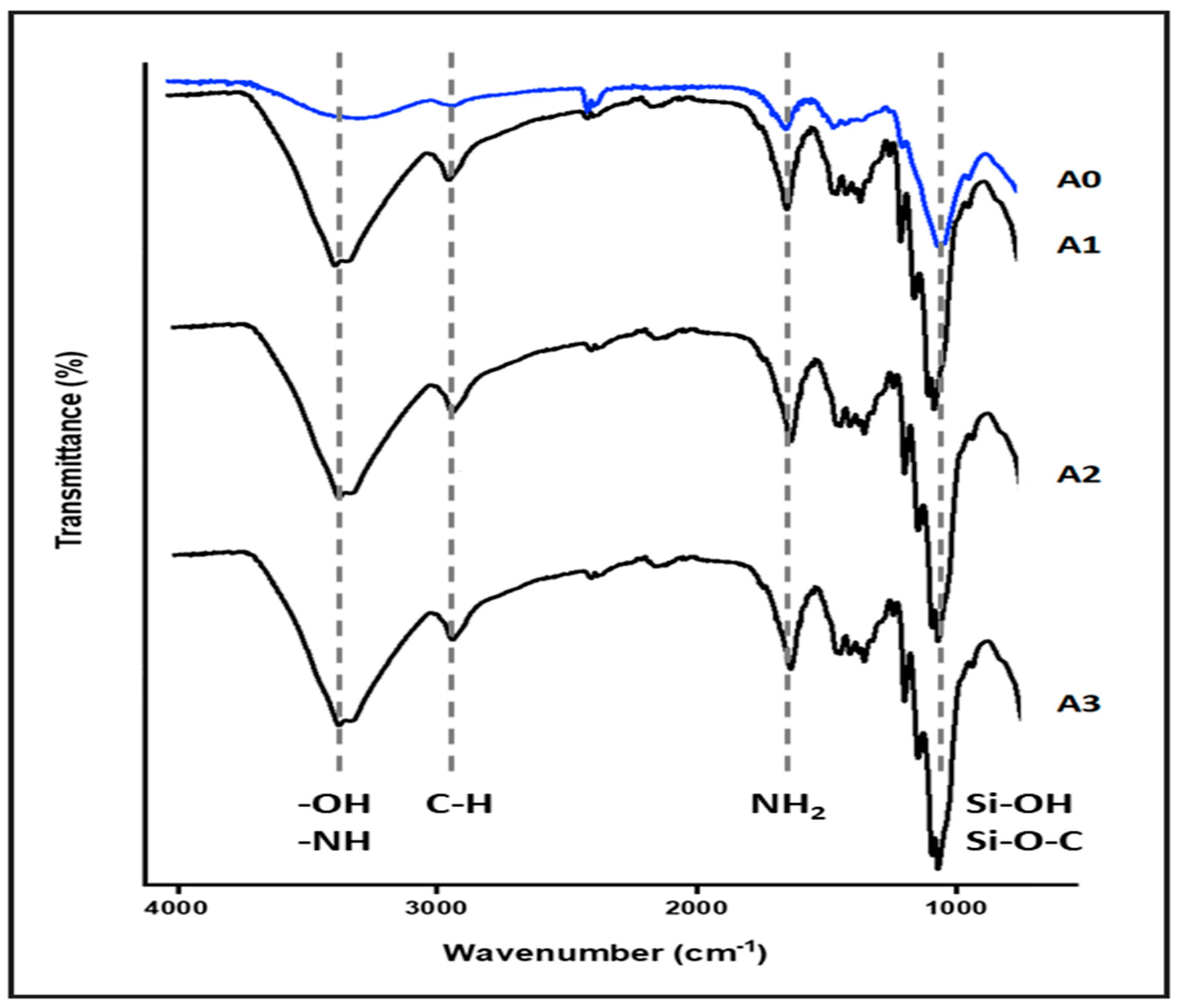
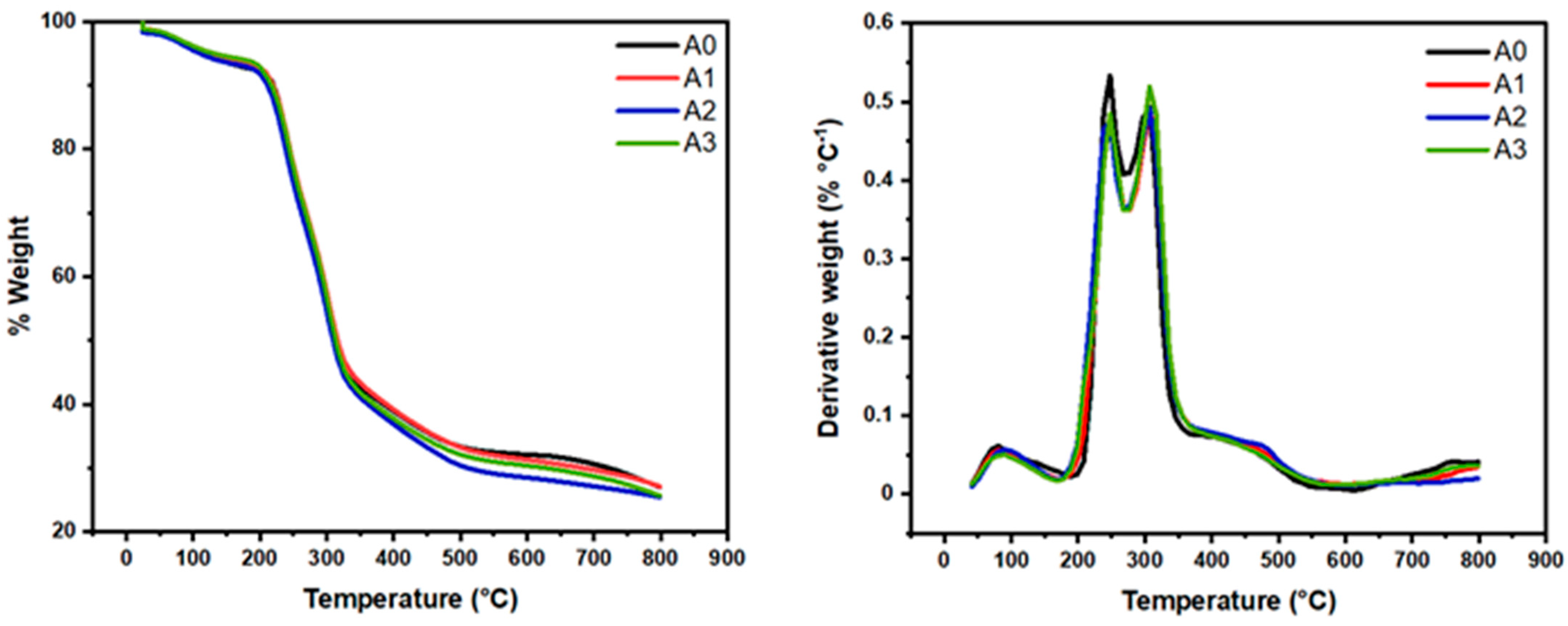
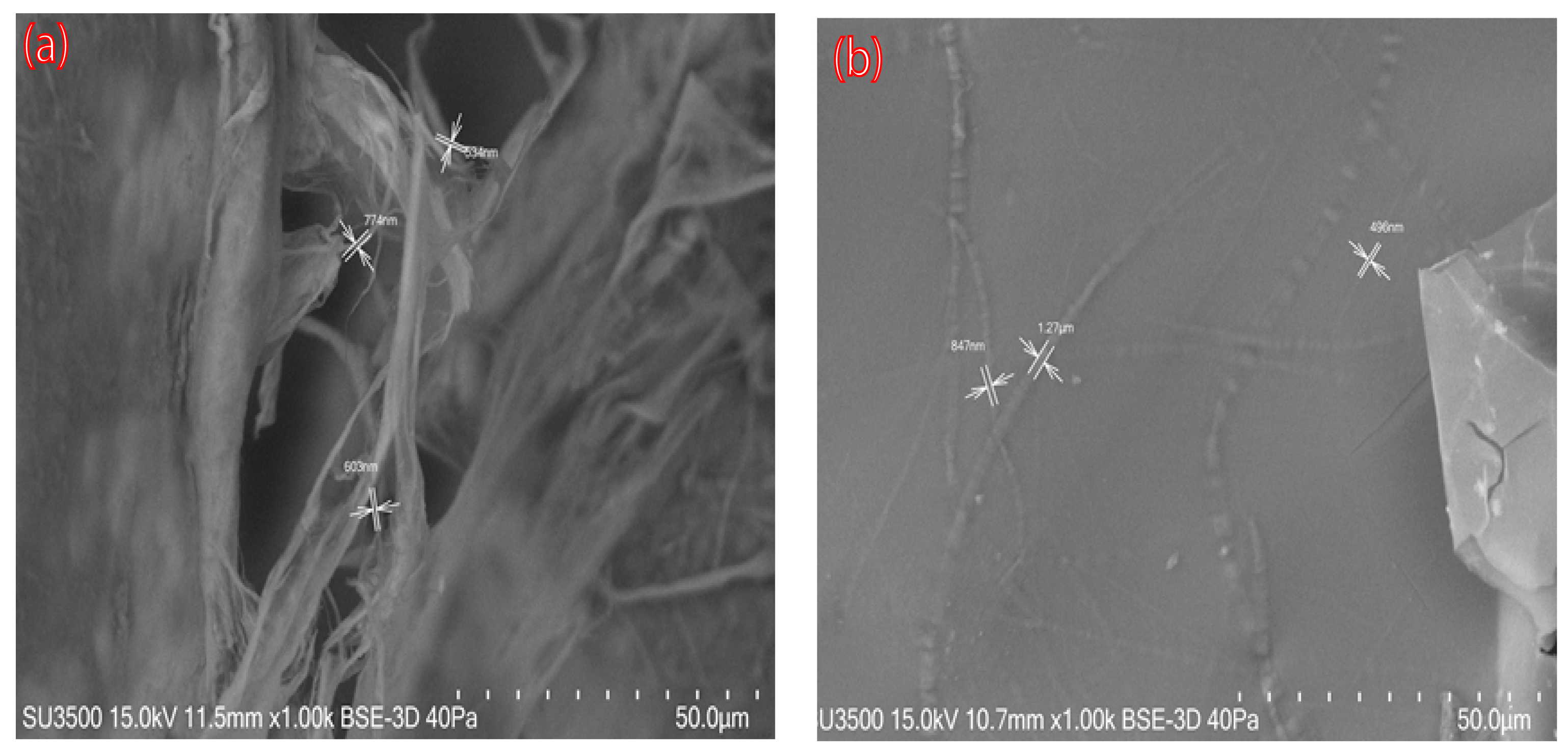
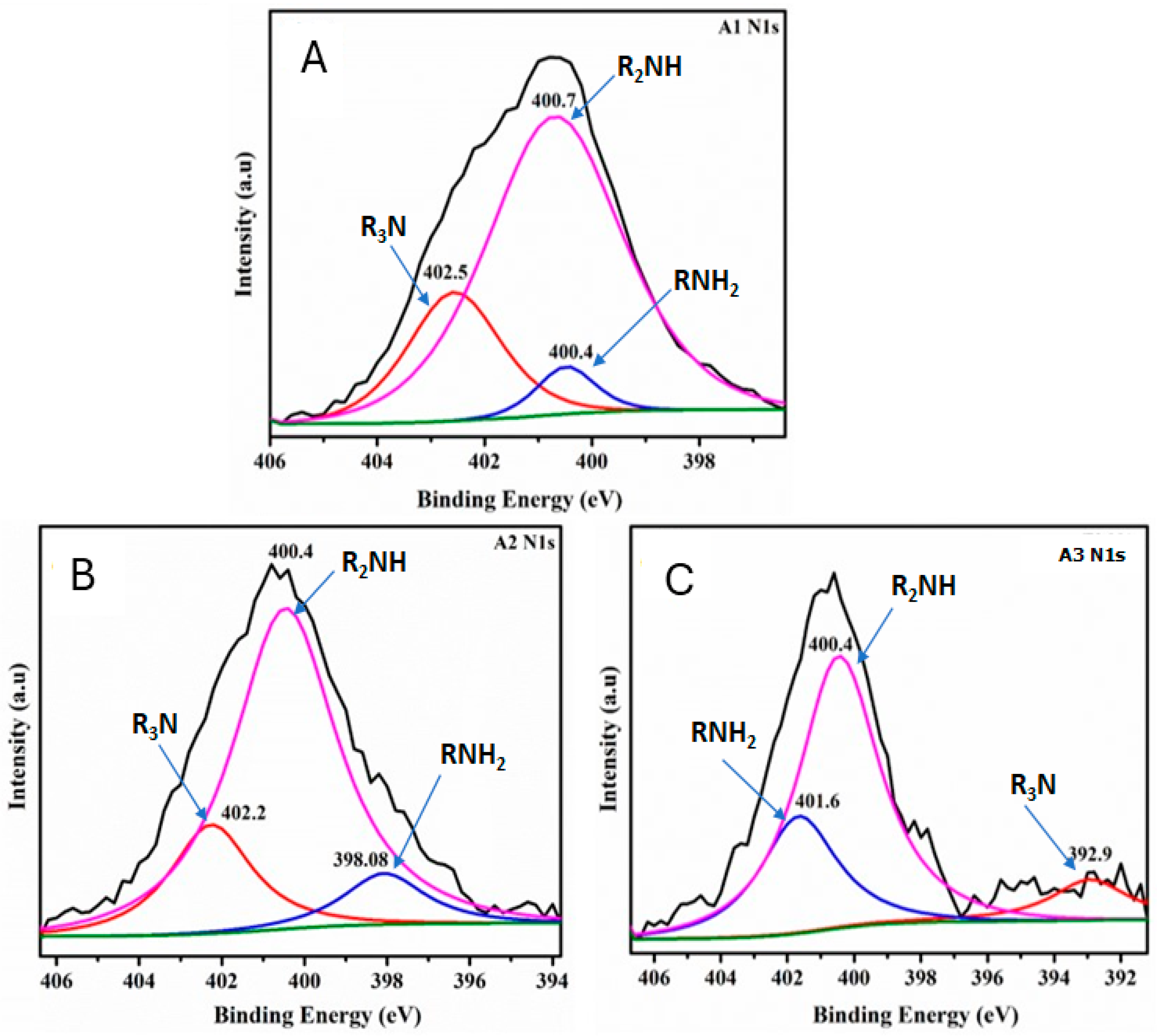

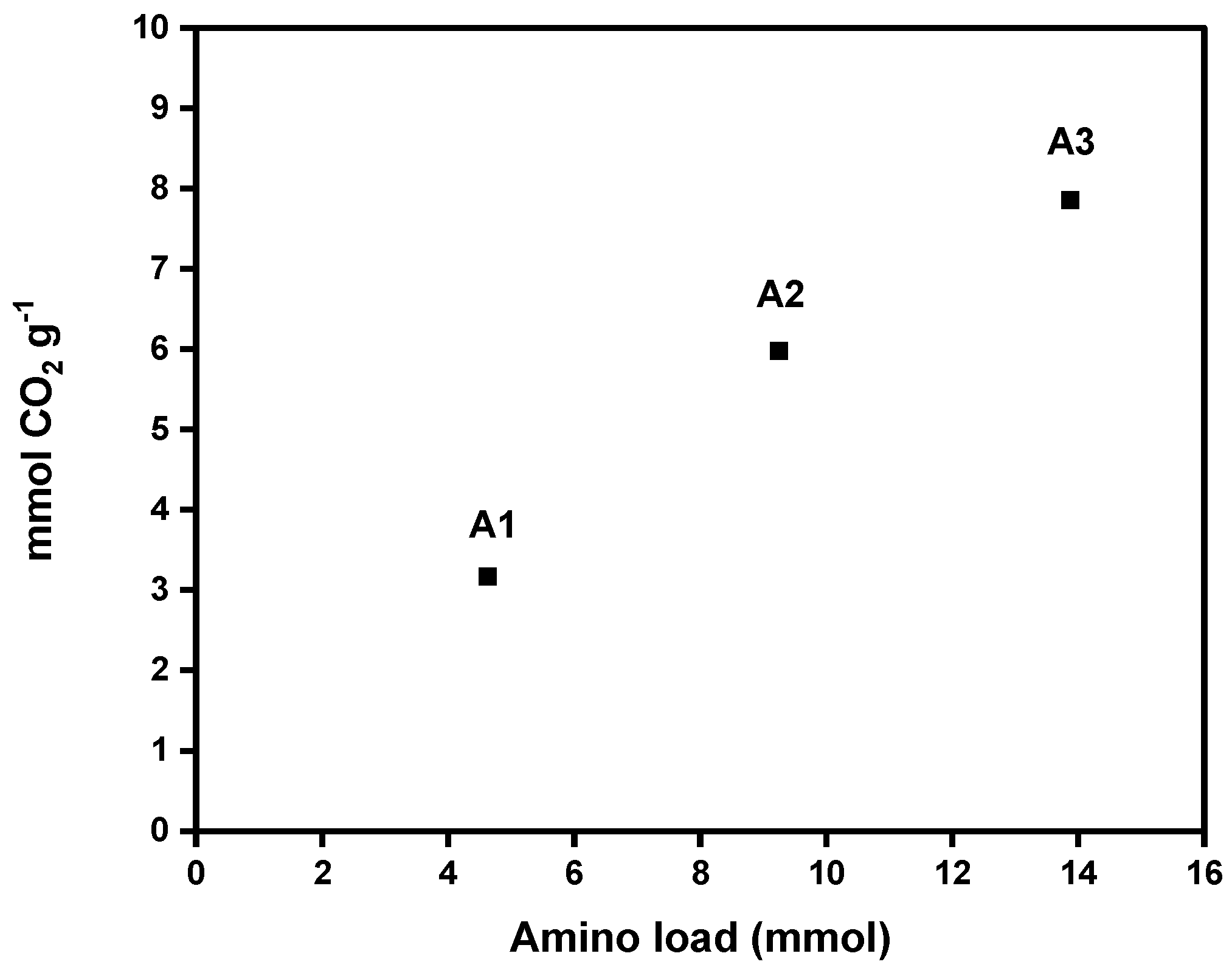
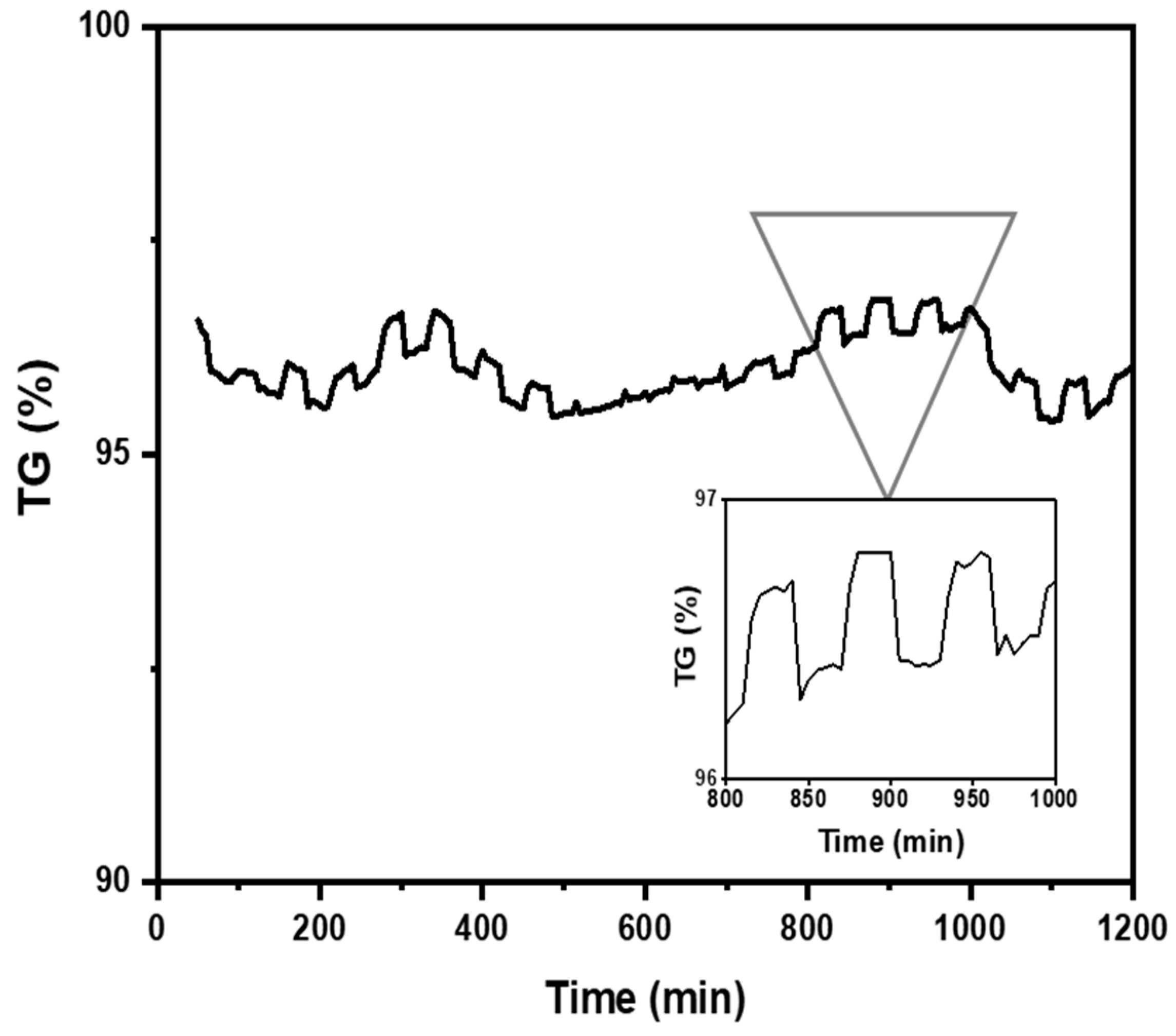
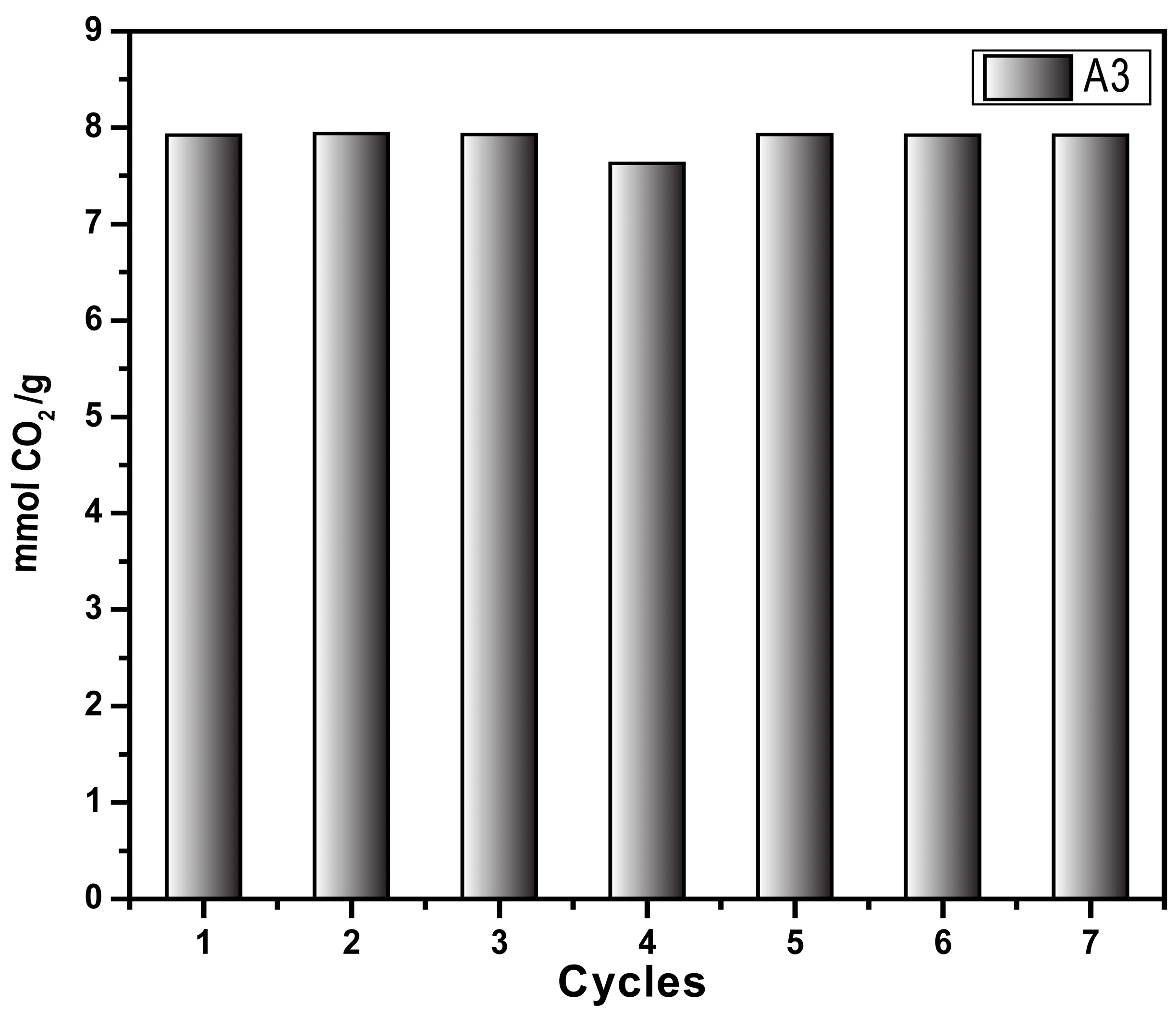
| Isotherm | Equation |
|---|---|
| BET | |
| Langmuir | |
| Freundlich | θ = KP1/n |
| Temkin | θ = A ln (B.P) |
| Sample | C wt.% | H wt.% | N wt.% | O wt.% |
|---|---|---|---|---|
| A0 | 39.25 | 5.68 | 0.07 | 55.0 |
| A1 | 39.80 | 6.13 | 0.35 | 53.7 |
| A2 | 39.77 | 6.40 | 1.55 | 52.8 |
| A3 | 39.97 | 6.75 | 2.74 | 50.5 |
| STD * | 71.64 | 6.64 | 10.42 | 11.3 |
| Isotherms | Parameters | A1 | A2 | A3 |
|---|---|---|---|---|
| BET | S (g/cm3 STP) | 0.2216 | 0.1843 | 0.2037 |
| Y (g/cm3 STP) | –0.0044 | –0.0034 | –0.0036 | |
| R | 0.9980 | 0.9982 | 0.9981 | |
| Qm (cm3/g STP) | 4.6032 | 5.5292 | 4.997 | |
| Langmuir | S (g/cm3 STP) | 0.1695 | 0.1341 | 0.1576 |
| Y (g/cm3 STP) | –1.2550 | –0.3500 | –1.0360 | |
| R | 0.9988 | 0.9997 | 0.9987 | |
| Qm (cm3/g STP) | 5.8963 | 7.4543 | 6.3445 | |
| Freundlich | S | 6.8946 | 6.5043 | 7.4617 |
| R | 0.7788 | 0.8586 | 0.7864 | |
| Qm (cm3/g STP) | 2.7227 | 3.2204 | 3.1092 | |
| Temkin | S (mmHg−1) | 268.6050 | 94.1404 | 441.948 |
| R | 0.7887 | 0.8860 | 0.8080 | |
| Qm kJ mol−1 (cm3 g−1 STP) | 1.2021 | 0.8736 | 1.1657 |
| Sample | BET Area (m2 g−1) | Qm (cm3 g−1) | X0 (mmol g−1) |
|---|---|---|---|
| A0 | 94.00 | – | – |
| A1 | 154.00 | 4.60 | 0.21 |
| A2 | 154.80 | 5.52 | 0.25 |
| A3 | 154.30 | 4.99 | 0.22 |
Disclaimer/Publisher’s Note: The statements, opinions and data contained in all publications are solely those of the individual author(s) and contributor(s) and not of MDPI and/or the editor(s). MDPI and/or the editor(s) disclaim responsibility for any injury to people or property resulting from any ideas, methods, instructions or products referred to in the content. |
© 2025 by the authors. Licensee MDPI, Basel, Switzerland. This article is an open access article distributed under the terms and conditions of the Creative Commons Attribution (CC BY) license (https://creativecommons.org/licenses/by/4.0/).
Share and Cite
Valdebenito, F.; Albornoz, C.; Rivera, V.; Elgueta, E.; Nisar, M.; Lira, S.; Valerio, O.; Narváez, A.; Quezada, C.; Muñoz, R.; et al. Stable Reusability of Nanocellulose Aerogels with Amino Group Modification in Adsorption/Desorption Cycles for CO2 Capture. Materials 2025, 18, 243. https://doi.org/10.3390/ma18020243
Valdebenito F, Albornoz C, Rivera V, Elgueta E, Nisar M, Lira S, Valerio O, Narváez A, Quezada C, Muñoz R, et al. Stable Reusability of Nanocellulose Aerogels with Amino Group Modification in Adsorption/Desorption Cycles for CO2 Capture. Materials. 2025; 18(2):243. https://doi.org/10.3390/ma18020243
Chicago/Turabian StyleValdebenito, Fabiola, Camila Albornoz, Valentina Rivera, Elizabeth Elgueta, Muhammad Nisar, Sebastian Lira, Oscar Valerio, Ana Narváez, Carolina Quezada, Robinson Muñoz, and et al. 2025. "Stable Reusability of Nanocellulose Aerogels with Amino Group Modification in Adsorption/Desorption Cycles for CO2 Capture" Materials 18, no. 2: 243. https://doi.org/10.3390/ma18020243
APA StyleValdebenito, F., Albornoz, C., Rivera, V., Elgueta, E., Nisar, M., Lira, S., Valerio, O., Narváez, A., Quezada, C., Muñoz, R., Azócar, L., & Sandoval, F. (2025). Stable Reusability of Nanocellulose Aerogels with Amino Group Modification in Adsorption/Desorption Cycles for CO2 Capture. Materials, 18(2), 243. https://doi.org/10.3390/ma18020243






